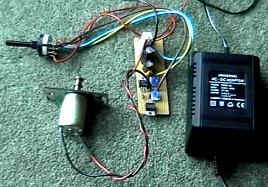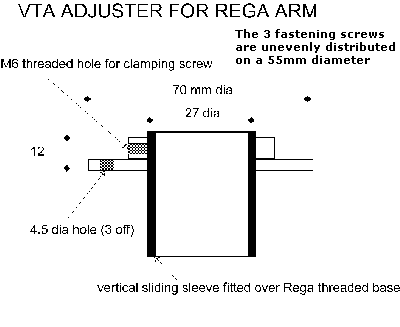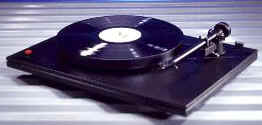The Origin Live Basic Kit Turntable
| The Origin Live Basic Kit Turntable |
|
Paul Szabady |
|
10 November 2000 |
Origin Live Basic Kit Turntable
Optional upgraded power supply/regulator board
Optional pre-assembly and testing of said board
VTA adjustor
Optional basic MDF plinth
Price: US$ 880 plus $54 US Customs fee.
New fully modified RB250 tonearm
Price: $475.
(Note prices will vary based on exchange rate of the US dollar and the GB pound. Shipping included.)
Origin Live
87 Chessel Crescent, Bitterne,
Southampton, UK SO19 4BT
Phone: +44 (0)2380 442183 / 578877 Fax +44 (0)2380 398905
Web: http://www.originlive.com
Build-it-yourself audio kits are as old as our hifi hobby itself. Though down in general popularity from its heyday in the ‘50s and ‘60s, the availability of do-it-yourself (DIY) kits for speakers, preamps and power amps has remained consistent through the years. The recent vogue for SET tube amps and their need for high efficiency speakers has sparked a resurgence of interest in DIY kits and the DIY subculture is emerging from its almost underground status into the mainstream. Turntable kits, by contrast, have been short on the ground in the US, especially compared to the UK where innovative firms like Mark Baker’s Origin Live offer a wide array of turntable kits, tonearm modifications and motor upgrades for existing tables.
Two of the obvious attractions of kit building are saving money and the satisfaction of building a successful component. Those confident in their mechanical and technical abilities, and the intellectually curious, can participate in the elements of experimenting and designing. Loudspeaker DIYers skilled in woodworking can eliminate a large percentage of the cost by building the cabinet themselves, and many contemporary tube electronics kits are available at substantial savings.
The market for DIY kits, however, will always be limited by the number of enthusiasts with the requisite mechanical and technical skills. My own interest in DIY kits has been rather low–mostly due to lack of the necessary skills and tools. But because I worked in audio for 25 years, I did develop the skills necessary to accurately and professionally set up turntables and cartridges. Necessity is the realmother of skill acquisition – but in general my innate mechanical talents lie closer to The Three Stooges than to the fabled Norm Abrams of PBS’ “This Old House” and “The Yankee Workshop.”
I’ve reviewed Origin Live’s superb Rega arm modifications for this magazine and have the highest respect for OL’s head designer Mark Baker. He’s one of a rare species–a skilled engineer who can actuallyhear, who has the imagination to think outside of the conventions and dogmas of hi-fi faddism, and who focuses on producing an extremely high performance/cost ratio. Since I own 4 turntables in need of motor improvements I was intrigued by glowing reports of OL’s DC motor upgrade. I was also intellectually curious to test the ultimate effectiveness of the Aurios Media Isolation Bearings with turntables so I decided to overcome my diffidence with DIY and try one of their kits.

I note with chagrin that contemporary AC motor design has become increasingly complicated and expensive. The simple beauty of the AC synchronous motor is that it locks onto the AC line frequency to control its speed. Unfortunately the reliability of that constant has proven to be increasingly shaky over the years as our electricity has gotten more polluted. Most high performance turntables seeking to optimize synchronous motors have had to resort to elaborate designs to guarantee the requisite control. Linn’s top-of-the-line Lingo power supply, as one example, uses what amounts to a very high quality and expensive amplifier to generate that one reference frequency. While these increasingly complex and elaborate techniques do work, the cost is high. A $1500 amplifier driving a $90 motor somehow just seems wrong.
Origin Live uses a DC motor to drive the subplatter/platter via a flat belt. Sourced from Holland, this new design is claimed to be free of the cogging that plagued older DC motors and is so low in vibration that it need not be isolated from the plinth. With OL’s optional power supply and regulator board, the motor achieves its speed stability at 33 1/3 RPM to within a hundredth of a volt input (2.35 V on my sample), and holds it with no fluctuation on my digital voltmeter whatsoever. Forty-five RPM is equally steady. A slot on one side of the mounting plate of the motor, along with a requisite cut-out in the plinth, allows the motor to be moved in distance from the subplatter to adjust belt tension. Once the speed of the motor is set with the variable resistors on the regulator board (one each for 33 and 45 RPM), one slackens the belt tension by moving the motor closer to the platter, trying to get it as close as possible without introducing speed fluctuations due to too loose of a belt. The directions for this procedure in OL’s instruction manual are rather opaquely written and it is a very tweaky process. Making this adjustment alters the sound subtlely but markedly. In essence one is changing the grip and control of the belt, its resonant frequency and its filtering characteristics as one slackens or tightens the tension. Getting it just right involves balancing transient snap versus harmonic richness and dynamic fullness based on the cartridge and the sonic characteristics of one’s support and isolation devices and, of course, one’s own sonic preferences. This adjustment is probably best left until late in the set-up process as the final fine-tuning after VTA/SRA adjustments are dialed in.
After isolation from the physical environment’s non-musical vibrations, the most important determinant of a record player’s ability to recreate music is the motor and its drive of the platter. The grossly obvious effects of inadequate speed control are wavering of pitch – the well- known wow and flutter. But once these are reduced to below audibility, inadequate speed control destroys the basic fundamentals of music. If the table’s motor drive doesn’t allow the beginning and ends of individual notes (the initial transient, the first arrival and the decay) to be reproduced correctly, along with the equally important spaces between those notes, no tone arm or cartridge in the world will be able to recreate life-like pitch, timbre, tempo, rhythm, phrasing, or dynamics. We all know this intellectually, but experiencing it concretely highlights its importance.
I’ve listened to the changes in motor drive in the Linn LP12 (and other tables) over the years; from the Basic to the Valhalla to the Lingo, along with Naim Armageddon in addition to other non-Linn motor upgrades. Most recently I auditioned the new Rega motor upgrade to the venerable Planar 3. The differences and improvements in musical clarity, fidelity, dynamics, and neutrality are supremely important. OL’s DC motor is as musically communicative as any I have heard. It is definitely running with the top dog ‘tables, though its price would erroneously lead you to suspect it’s figuratively a Dachshund.
Next in importance to a turntable’s performance is the platter and its bearing. OL uses a sub-platter, whose bottom spindle extension rides on a ball bearing in an oil-bathed bearing holder. The outside of the bearing holder is threaded; two nuts allow adjustment in the vertical plane and secure the bearing holder to the plinth. OL supplies a special military-spec “Arctic-grade” oil. The bearing holder doesn’t look glamorous, but is simple, works great and is very cost effective (stethoscope listening revealed no bearing noise).
OL offers 2 platter choices. I chose the cheaper one for cost reasons and because I use the Ringmat, which decouples the record from the platter and makes the platter’s material sonic contribution largely a non-issue. My discovery of the Ringmat ended my long frustration with heavy platters and the sonic inconsistencies and trade-offs of record clamping.
I had ambitious plans for building my own plinth to take advantage of the Cromolin Vibration Control damping strips and Aurios Media Isolation Bearings. Cromolin had already shown me the effectiveness of constrained layer damping when used on budget-priced electronics’ chassis. They are the most cost-effective when used on flat metal surfaces, which also appears to be the case with the Aurios MIBs. It is easier to get true flatness from metal as opposed to wood (essential to allow the Aurios to float the component.) My inclination was towards an aluminum or stainless steel Rega-like plinth of low weight and mass.
Designing and constructing a plinth from scratch has its pitfalls, the first being having no benchmark to judge success or failure. To keep things easy and to provide that benchmark, I chose to start with OL’s simple 1-inch medium-density fiberboard (MDF) plinth. This has cuts in it to shorten resonance paths and places the arm mounting area on a pie slice-like peninsula. The plinth is precut with mounting holes for the motor, bearing, arm, and switch, though I had to slightly enlarge the arm-hole to accommodate the VTA adjuster.

The VTA adjuster uses a cylindrical aluminum sleeve into which the Rega’s armbase pillar slides, the arm resting on the top of the sleeve. This sleeve then moves vertically in a plinth-attached collar allowing arm height adjustment for VTA/SRA. A grub screw in the collar bears on the sleeve to hold the arm in place.
The finished product resembles a Rega Planar 3 in appearance–motor, arm and platter attached to the piano-black plinth, with isolation supplied by one’s choice of feet.
So How Does It Sound Already?
By any standard this is an excellent turntable. A neutral and transparent platform, it allows the arm and cartridge to do its job. It offers top-drawer speed control, superb dynamics, rhythm and drive, evenly balanced frequency response, exquisite fine detail, and articulate communication of the instrumental performance. With this turntable, understanding the musical message was easy. It does this without artificial edginess, harshness, or mechanical plodding. That it achieves all this at an affordable price evokes deep joy.
I listened to a variety of cartridges, spanning a range of prices (from $180 to $600 plus the $2500 Lyra), and types: the Grado Signature Jr, Signature TLZ-V, Sonata Reference (oh what a joy NOT to hear the Grado Hum!), Shure V-15 V MR and xMR were the moving magnet samples. The Lyra Helikon, Goldring Eroica LX, Talisman Boron, and Audio Technica AT OC9 were the low-output moving coils with line-contact styli; Denon’s DL 160, Sumiko’s Blue Point and Blue Point Special represented high-output MCs with elliptical stylus shapes. The difference in resolution between line-contact stylus designs and their elliptical brethren was easily heard. With each cartridge I was pleased to hear genuinely musically, communicative sonics, and while the differences in sound were marked and vivid, I was pleased to find strong virtues in cartridges that had previously either crossed the line into sterility or edginess, or had simply been too mellow, blurred, and vague.
I listened to the phono stage of the Meitner PA 6i primarily, and supplemented this with auditions with the Herron MC phono and line preamp, the Audio Alchemy VAC-in-a-Box, the new Musical Fidelity XLPS, the Musical Surroundings Phonomenon, and the Hegemann HAPI One and Two preamps. While I got excellent musical results with all of them, higher resolution designs obviously passed more musically relevant information and it is worth using as good a phono stage and cartridge as one can afford. The ‘table was not outclassed in driving the Helikon/Herron combination, which when you consider the gross cost differential highlights the table’s abilities.
Listening to string quartets and small jazz combos allowed the musical conversation to emerge without muddling, often a difficult task. Switching to West African polyrhythmic music, I was easily able to follow 6 different rhythms simultaneously. I developed a deeper insight into Miles Davis’ playing – the cool, ultra-hip façade disintegrated and allowed the real man to emerge from behind the mask. Classical recordings that I had pooh-poohed as either hopelessly diffuse or hopelessly etched became coherent and meaningful. The basics of music: pitch, rhythm, tension, release, pulse, phrasing, and dynamics are very well served, as is the timbre of instruments. And it passed my violin test with flying colors. On well-recorded material with a natural soundstage, 3-D stereo effects were precise, though this is not at the top on my overall hierarchy of musical values.
So, It’s Perfect, Right?
Well no. A record player has an almost impossible job and I suspect that a perfect turntable is an impossibility. I would like a bit more rhythmic drive. The other limitations I attribute mostly to the sonic signature of the MDF plinth, as it is similar to, though far less noticeable, than the wood-based plinths I’ve listened to over the years. A slight transient slurring, most noticeable on a few bass notes that sound wooden (I suspect most listeners would find this nitpicking) and a slight lack of ultimate clarity is evident. The limitations are subtractive rather than additive, hence non-irritating. One can’t expect the world from a $65 MDF plinth, especially in a simple suspension-less design.
Since this simple plinth design depends upon its feet and support to supply vertical and horizontal isolation, I tried a variety of isolation techniques and products: simple spikes, Vibrapods, NavCom Silencers, A.R.T. Q-Dampers, Aurios Media Isolation Bearings, Tip Toes, Blu Tack, marble and glass sandwiches, the Townshend Seismic Sink (old style, not the new 3D version) and various combinations of the above. At times the result resembled a Dagwood sandwich about to turn into the Leaning Tower of Pisa! The differences in these set-ups sonically and musically were instantly obvious and roughly resembled in type the effects gained with proper motor belt tension and VTA adjustment but on a larger scale. Depending on one’s cartridge choice, belt tension adjustment, and VTA setting, it is possible totune the table along a continuum from soft-focus mellow euphony to deep-focus 3-D clarity by use of the appropriate support. The best and happiest blend of the 2 was attained with 3 tall Tip Toes attached to the plinth with just enough Blu Tack to keep the whole shebang from slipping off. The Tip Toes then rested on 3 Q-Dampers (these are ceramic-like squares of about 2 inches to a side with a circular brass insert indented to hold the point of a spike or Tip Toe,) which then rested on the Seismic Sink. The floor was concrete. Equally good, but different sonically, was the same setup with the Aurios MIBs inserted between the Q-Dampers and the Seismic Sink
Because the platter bearing extends below the plinth too far to allow the Aurios MIBs to float the table, I was not able to completely satisfy my curiosity about the ultimate ability of the MIBs in this turntable application. Placing the Aurios directly under the plinth, with the Q-Dampers below it for necessary clearance, highlighted the sonic signature of the plinth’s resonances.
So How Difficult Is It to Build?
OL’s instructions mention that, for some, it might be a challenge. Ideally one should know how to solder, stuff a circuit board, and have the woodworking tools and experience to drill holes accurately. If one is designing their own plinth, one obviously needs to know how to work the material, cut the holes, etc. OL sells the power supply/regulator board preassembled and tested for an additional 25 pounds: this is well worth the money. In addition, one needs to wire up the switch and solder the connections to the motor. Any technician could do the whole thing in an hour. If one buys the plinth from OL and wants to use their VTA adjuster, having OL drill the proper size hole will cut assembly time.
The instructions are adequate, if not tightly organized. Builders of Dynakits and veterans of other classic kits might find the instructions somewhat confusing in comparison. OL’s products continue to evolve and at times it’s hard to tell if the in-hand items match the instructions. A thorough re-editing and revision of the manual would be make things clearer, but with a little patience, care, thought and planning, the instructions will answer most questions. And Mark Baker is only an e-mail away.
I found the Origin Live kit turntable to be a somewhat high-spirited thoroughbred that requires conscious and sensitive tuning of a variety of adjustments: the speed of the motor, the tension of the belt, VTA, and correct suspension/isolation, to give its best. But oh how musical that best is! Less than careful adjustment still produces a very good sound, but it is worth the extra effort and time to identify the sonic results of these variables in order to extract the ‘table’s maximum potential. A tweaker’s delight? Well yes, and those expecting a turnkey turntable might be a bit intimidated, but perhaps all kit builders will accept this necessary fine-tuning as part of the challenge. Once the fine adjustments are made, one just forgets the ‘table and plays music. Considering the very reasonably-priced upgrade path available (an upgraded AC transformer, a subchassis option, and the use of different plinth materials), one can grow with this turntable over time–as I plan to do. All in all, it’s an exceptionally good value (OK, it’s a steal) and a deeply satisfying, musical turntable.
![]()
Don’t forget to bookmark us! (CTRL-SHFT-D)
Stereo Times Masthead
Publisher/Founder
Clement Perry
Editor
Dave Thomas
Senior Editors
Frank Alles, Mike Girardi, Russell Lichter, Terry London, Moreno Mitchell, Paul Szabady, Bill Wells, Mike Wright, and Stephen Yan,
Current Contributors
David Abramson, Tim Barrall, Dave Allison, Ron Cook, Lewis Dardick, John Hoffman, Dan Secula, Don Shaulis, Greg Simmons, Eric Teh, Greg Voth, Richard Willie, Ed Van Winkle, Rob Dockery, Richard Doron, and Daveed Turek
Site Management Clement Perry
Ad Designer: Martin Perry






Be the first to comment on: The Origin Live Basic Kit Turntable